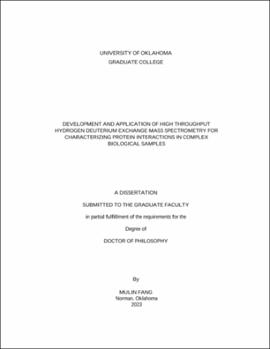| dc.description.abstract | Protein interactions (e.g., protein-protein interactions and protein-ligand interactions) play an important role in regulating the numerous biological processes that dictate cellular activity. The characterization of protein interactions in their native, complex biological environments (e.g., cell lysate and human plasma) is essential for understanding protein function in real physiological processes. However, the extremely complex nature of biological protein samples impedes the characterization of protein interactions by traditional biophysical methods. Hydrogen–deuterium exchange coupled with mass spectrometry (HDX-MS) has been a powerful technique for characterizing protein interactions over the past 20 years. However, this technique has yet to be adapted to directly characterize protein interactions in real biological samples. This dissertation focuses on the development and application of a high-throughput HDX-MS platform to characterize protein interactions in complex biological samples (e.g., cell lysate and human serum).
The implementation of short LC gradients in the traditional HDX-MS workflow has been necessary to limit back exchange. These short gradients limit separation efficiency and hinder high throughput HDX-MS analysis of protein interactions in complex biological samples. We first evaluated and optimized subzero-temperature ultra-high-pressure liquid chromatography (UPLC) separation conditions for long gradient separation to boost separation power for the HDX-MS analysis of complex protein samples such as E. coli cell lysate digest while limiting back exchange. We found that, compared to the short gradient separation (e.g., 15 minutes), about 3-fold more deuterated peptides could be characterized using long gradient separation (e.g., 90 minutes). Interestingly, we found that peptides eluted at the end of the long gradient maintained high levels of deuterium incorporation due to the peptide-column interactions. Overall, under the optimized conditions, our subzero-temperature long gradient UPLC-HDX-MS platform is capable of characterizing thousands of peptides from hundreds of proteins in a single HDX-MS analysis with limited back-exchange.
To further reduce the complexity of the complex biological samples, we improved our platform by integrating protein thermal depletion (PTD) to reduce protein complexity in cell lysates with our subzero-temperature UPLC-HDX-MS platform (PTD-HDX-MS). PTD allows the removal of the untargeted protein in the cell lysate with lower thermal stability upon exposure to heat while the targeted protein with higher thermal stability remains in solution. We used bovine carbonic anhydrase II (CaII) and its inhibitor acetazolamide (AZM) spiked into E. coli cell lysate as a model system to evaluate the feasibility of our PTD-HDX-MS platform for the characterization of protein-ligand interaction in complex samples. We demonstrated that PTD is an easy and universal strategy to reduce overall sample complexity for HDX-MS analysis. For the first time, we successfully elucidated the interaction site between AZM and CaII in E. coli cell lysate using high-throughput HDX-MS analysis. Our results highlight the great promise of the PTD-HDX-MS platform for the identification of ligand targets and the characterization of protein–ligand interactions in highly complex biological samples such as cell lysates.
With our optimized HDX-MS platform, we mapped the antibody–antigen epitopes with four fully human monoclonal antibodies (mAbs) specific to anthrax protective antigen (PA). Epitope-mapping of mAbs to PA is particularly important because it can help develop novel therapeutics against anthrax. We examined the epitopes for 4 mAbs that were known to have differential neutralizing abilities. We discovered diverse binding mechanisms for these 4 mAbs and, notably, found that a high neutralizing mAb, p6C01, strongly bound to domain three on a helix region on PA. We also identified a secondary epitope for p6C01 that may lead to inhibition of furin cleavage of PA after p6C01 binding. This study demonstrated that the unique epitope for p6C01 results in its highly neutralizing activity. This is the first report of this distinct binding mechanism for a highly neutralizing fully human antibody specific to anthrax protective antigen. These novel epitopes associated with high neutralization activity will facilitate the understanding of the elicited human humoral immune response following AVA vaccination. Overall, characterization of the interaction between vaccine-elicited antibodies and antigens is important for understanding the fundamentals of how a vaccine works, and epitope mapping is especially essential for the development of effective therapeutics. Our high-throughput HDX-MS platform has proven to be capable of discovering novel epitopes relevant to human immune response.
Different population demographics may demonstrate varying levels of immunity after vaccination due to the diversity in expression of vaccine-elicited polyclonal antibodies (pAbs). Therefore, epitope-mapping of vaccine-elicited pAbs is essential for a better understanding of vaccine-induced immune protection. However, due to high sample complexity and the unpredictable binding properties of pAbs, very few techniques can be applied for conformational epitope-mapping of pAbs directly in patient serum. We applied our PTD platform discussed previously to remove unbound antigens to increase the sensitivity for characterization of pAbs-induced epitopes using HDX-MS. We successfully characterized the epitopes induced by vaccine-elicited pAbs in isolated serum antibodies from human donors vaccinated with AVA against PA using PTD-HDX-MS. Overall, our results demonstrate the great potential of the implementation of PTD-HDX-MS for conformational epitope-mapping of pAbs in human-vaccine elicited samples. | en_US |
